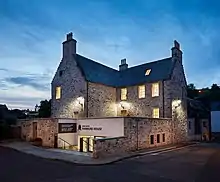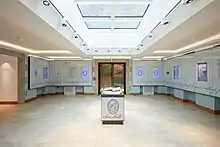Panmure House (Edinburgh)
Description



Panmure House is a 17th-century townhouse located in Edinburgh's Canongate, just off the Royal Mile. It is the only surviving residence of renowned Scottish economist Adam Smith, who lived there between 1778 and 1790. Situated close to the Scottish Parliament, in the heart of a UNESCO World Heritage Site, the House is an important monument of Scottish intellectual history. During his time living at Panmure House, Smith continued to study and write, producing four new editions of his magnum opus The Wealth of Nations between 1778 and 1789. He was still at work on the final edition of his 1759 master work, The Theory of Moral Sentiments, when he died in Panmure House in 1790 and is buried in the nearby Canongate Kirkyard.
Now an A listed building, Panmure House is the last and only surviving Smith residence, which was bought by Edinburgh Business School, the business school of Heriot-Watt University in 2008; the School commissioned the restoration of Panmure House into a centre of learning and debate, and to provide a resource for students, businesses and the local community. The restoration of Panmure House was completed in mid-2018, ahead of the official opening by former British Prime Minister, Gordon Brown, in November 2018.
Restoration
Panmure House was in a state of disrepair when it was purchased due to several years of neglect. The restoration took several years and was expertly executed. Restoration work was carried out on the exterior and interior of the House. The exterior work included rebuilding the tall chimney stacks, re-slating the roofs, repairing the stone walls and renewing the windows. The renovations also included digging out the original basement to create a contemporary extension to the building which now houses a modern Interpretation Suite where visitors can learn more about the House, Smith, and the Scottish Enlightenment before continuing into the rest of the house. Archaeological investigations carried out by local archaeologists, Addyman Archaeology, below the building uncovered a well and several medieval kilns.
Work inside the house concentrated on reconstructing interiors typical of the late 1700s, using materials and techniques that were likely used in Smith’s time. The interiors are striking and feature North American tulipwood timber panelling. A new stone staircase was added made out from Clasach stone and original stone hewn from 17th-century Lothian quarries which would have been hauled by horse and cart to the capital. The stone used throughout the House is bright and golden, encased in lime mortar and the sand was brought in from pits near Leslie in Fife. The interior reflects a sophisticated blend between modern and period which has created a unique space consisting of a modern building with steelwork, concrete, digital screens and cabling all exquisitely concealed behind the paneling, architraves and skirtings. The renovation also added new stone fireplaces, oak floors and lime plasterwork. The original roof timbers have been preserved in the attic and carry the original joiners' marks on them, numbering the trusses in Roman numerals.
Notable visitors
Panmure House in the late 1700s was not only a place of academic study, it was alive with discourse and debate. Key figures of the Scottish Enlightenment were regular visitors; James Hutton, founder of modern geology, Joseph Black, founding father of chemistry, Robert Adam, the neoclassical architect, David Hume, Scottish philosopher, William Robertson, Edinburgh University principal and historian, Hugh Blair, Professor of Rhetoric, Samual Rogers, English poet and Dugald Stewart, philosopher and mathematician, were some of the distinguished names to be welcomed here.
Modern Day use
Inspirational Alba
A series of events designed to celebrate Scotland’s intellectual and cultural contributions to the world, aptly delivered from the final home of Adam Smith. The inaugural session was delivered in January 2020 by Andrew Gilmour, Former Assistant Secretary-General in Human Rights, on ‘A Scots View from the UN’.
Adam Smith Lecture Series
A high-calibre lecture series inviting the world’s best economic thinkers, practitioners and Nobel Laureates return to the birthplace of modern economics to deliver original keynote lectures of global relevance. The inaugural lecture was presented by Andy Haldane, the Chief Economist of the Bank of England. The series involves high-profile, biannual keynote lectures by Nobel Laureates in Economics and selected practitioners of equivalent prominence and calibre.
The Hutton Series on Climate Change
A series named after James Hutton, the father of modern geology and the executor of Smith's will and a frequent visitor to Panmure House. The discussions held there then, at the dawn of the industrial revolution, resonate strongly with those required now as we grapple with a global energy use transition. The Hutton Series on Climate Change is a series of events taking place across 2020-21 at Panmure House, bringing together a diverse cross-section of experts, business leaders, scientists, and concerned citizens in the service of one aim: to identify ten key priorities, innovations & actions to mitigate climate crisis.
Edinburgh Fringe Festival
Since 2018, Panmure House has been Venue 305 at the Edinburgh Fringe Festival. In 2019, Panmure hosted three shows: The Butcher, The Brewer, The Baker... and the Commentator which revived Smith’s tradition of enlightened debate at Panmure for the 21st century. The format followed an economics panel debate show fronted by MoneyWeek Editor-in-Chief Merryn Somerset Webb. The second show was titled Dominic Frisby Presents Adam Smith: Father of the Fringe. This show explored how Adam Smith’s Invisible Hand is prevalent at the Fringe Festival itself. The final show was a play titled Adam Smith: The Invisible Hand which was brought to life by four professional Scottish actors. Written by Kirkcaldy playwright John Yule, the plot explores what might happen if Smith’s lost papers were recovered in the modern day. The dramatisation of Smith’s life and works, performed in his own drawing room at Panmure, presents Jean Jacques Rousseau, Voltaire, Robert Burns, and Smith’s mother Margaret, taking the audience on a journey through the enlightenment.
Smith Schools' Seminars
From Autumn 2021, Panmure House will facilitate and deliver the Smith Schools’ Seminars. This programme is designed to inspire and educate school pupils about the life, work and times of Adam Smith and the profound influence of the Scottish Enlightenment across the world. The Seminars are designed with skills development and critical thinking as key objectives.
Further reading
- Hirst, Francis W. (1904). Adam Smith. Macmillan.
- Fay, C. R. (1956). Adam Smith and the Scotland of His Day. Cambridge: University Press.
- "Scottish Notes: Civic Skyscraper for Lanark". Official Architecture and Planning. 20 (12): 620. December 1957. JSTOR 44128568.
- "Scottish Notes: Glenrothes May Take Glasgow Overspill". Official Architecture and Planning. 21 (2): 90. February 1958. JSTOR 44128016.
- "Dust-up over capital's crumbling landmarks". Edinburgh Evening News. 13 January 2010.
- Jamieson, Bill (15 January 2011). "The plight of Panmure House". The Scotsman. p. 18.
- "Public inquiry set for Adam Smith house". Building Design. 4 February 2011. p. 5.
- Ferguson, Brian (3 March 2011). "Glass atrium would 'hurt' historic Adam Smith house". The Scotsman. p. 24.
- Ferguson, Brian (4 March 2011). "Glass box will put Panmure House 'on the tourist map'". The Scotsman. p. 22.
- Ferguson, Brian (22 July 2011). "Go-ahead to a new future for Adam Smith's former home". The Scotsman. p. 24.
- Jamieson, Bill (31 July 2012). "Restoration frustration at Adam Smith's Panmure House in Edinburgh". The Scotsman.
- Rizzo, Ilde; Mignosa, Anna (2013). Handbook on the Economics of Cultural Heritage. Edward Elgar Publishing. pp. 491–. ISBN 978-0-85793-100-9.
- "Investigations at Panmure House". Edinburgh World Heritage. 26 September 2014.